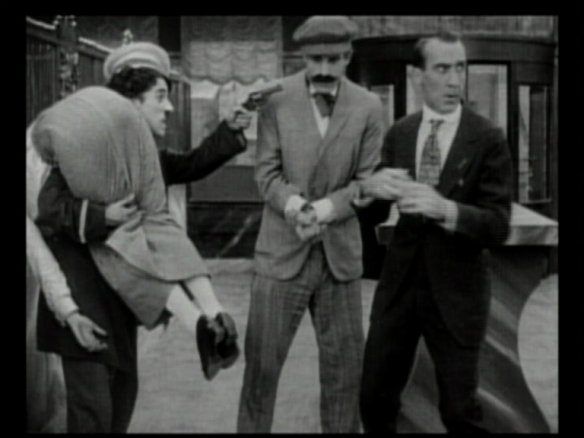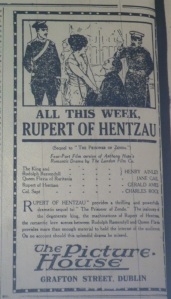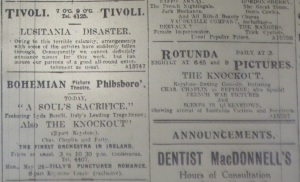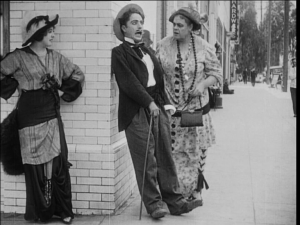On 12 September 1918, the lead article in the British trade journal Bioscope concerned a “bombshell from Ireland.” “The Irish Transport and General Workers’ Union [ITGWU],” it reported, “a powerful labour organisation with offices, singularly enough, at Liberty Hall, on Thursday last served a demand upon the proprietors of every cinema theatre in that part of the Kingdom which we can only describe as a monstrous one” (“Exhibitor His Own Enemy”). The ITGWU’s monstrous demand was for more pay for all cinema workers, which the leader writer saw as class war in the most literal terms. S/he urged the cinema owner “to answer the call of reason and gird on his armour against the foe that is ever present in our midst. We refer to the repeated upheavals in the domain of labour.”

The first item in the inaugural “Picture in Ireland” column concerned cinema in Galway; Bioscope 29 Feb. 1912: 593.
The Irish cinema industry had rarely featured so prominently in the Bioscope, where news from Ireland was usually corralled in the once regular column “Picture from Ireland” by a contributor or contributors identified as “Paddy.” Appearing first in the 29 February 1912 issue and thereafter regularly if not in every issue of the weekly trade paper, “Picture in Ireland” had for many years been the best source on Irish cinema. The information that the column provided was only superseded when Ireland’s first cinema magazine Irish Limelight appeared in January 1917. Even then, the weekly reports could catch things that the monthly Limelight missed.

Godfrey Kilroy was listed among the staff of the Bioscope who had joined the army on 22 Oct. 1914: 361.
For a brief period in 1916, Paddy was explicitly identified as Godfrey Kilroy, a fact already noted here, but the recent availability in the Bioscope in digital form – a development long wished for! – allows us to trace Kilroy’s name more forensically in the magazine’s pages. Born to a farming and land-agent family in Meath in 1890, Kilroy ended his career as the manager of a bank in Dunmanway, Co. Cork in 1955, but in the 1910s, he worked in the film business. Indeed, he may have been the original “Paddy” in 1912 because he was identified as an employee of the Bioscope in 1914, when his name appeared on one of the magazine’s “Roll of Honour” articles as a member of its staff who had enlisted. Kilroy’s period of military service must have been short because he was named as the Irish distribution agent – with an address at 34 Windsor Road, Dublin – for several film companies in late 1914, in 1916 and again in 1919.

This mention of Godfrey Kilroy asking to be placed on mailing lists suggests that he set up as a distributor in late 1914; Bioscope 17 Dec. 1914: 1187.
As an Irish-born and Dublin-based distributor, Kilroy no doubt had an intimate knowledge of the business in Ireland that informed the Paddy column and how it covered developments such as the strike in 1918. However, by September 1918, the column – now simply “Irish Notes” – was appearing less regularly, and indeed, after the 12 September issues, it did not appear in the journal again for the rest of the year. But on 12 September, Paddy did also discuss the strike at length, providing details that the leader writer left out.
Not surprisingly, the tone of the two articles was quite different, with the lead article delivering its news from Ireland as an admonition. Ireland’s cinema employers had apparently demonstrated too little organization in the face of a threat that in some respects “must be considered as coercive beyond degree, which is somewhat remarkable for the inhabitants of a land who never tire of crying out against anything in the least savouring of this type of oppression.” This latter general snipe about the Irish dislike of oppression was fuelled by the Irish industry’s preference for a separate Irish representative organization, the Dublin and South of Ireland Cinematograph Exhibitors’ Association (DSICEA), instead of membership of the Cinematograph Exhibitors’ Association (CEA), whose organ the Bioscope was. “[I]f anything could awaken them to the danger of longer holding aloof from the C.E.A.,” s/he contended, “this certainly should do so.”

Frank Leah’s caricature of Charles Grattan, manager of Dublin’s Picture House, Grafton Street; Irish Limelight 2:5 (May 1918): 1. Courtesy of the National Library of Ireland.
Other evidence suggests that Irish cinema employers had no problem in organizing in their own interest against labour. In May, the Irish Limelight had observed that “Mr. Charles Grattan, of the Grafton Picture House, certainly did the right thing when he convened an exhibitors’ meeting with a view to obtaining unity of action by cinema proprietors on the occasion when organised labour registered its protest against conscription” (“Notes and News”). The Limelight didn’t specify what the employers had done during the trade unions’ general strike against conscription on 23 April, “the most successful demonstration of workers political power in the revolutionary decade” (Yeates). Nevertheless, the employers had clearly acted together and seemingly effectively.

“Enough Said: ‘E looked at me, an’ I looked at ‘im.'” This cartoon commenting on how workers striking on the home front were letting down troops winning the war on the battle front carries a representation of working-class British speech in its caption, but it was reproduced in the Dublin Evening Mail 25 Sep. 1918: 3.
Following the general strike in April 1918, labour activity in Ireland certainly increased, and the cinema workers’ dispute in September was part of a much wider series of pay claims and strikes by workers in several industries. And this labour activity was by no means an Irish aberration; British workers were also engaged in major strikes,which many in the mainstream press saw as a malignant disease. “The strike fever is spreading in Dublin,” the Dublin Evening Mail’s editorial on 31 August observed, “and following a course similar to the recent influenza epidemic” (“Strike Fever”). At that point at the end of August, the Evening Mail noted disputes in the building and printing trades and among hotel workers; strike fever was about to become a lot more virulent. Under the 14 September headline “Industrial Unrest in Ireland,” the Irish Times focused on the threat of strike by national teachers but also reported on disputes by hotel and restaurant workers, printers, paper-mill employees, checkers at one of the steamship companies, flour-mill workers, tramwaymen, picture-house employees, Cork dockers, assurance agents, Derry bakers, and coalminers. In this context, the picture-house workers’ demand “for increased wages and shorter hours of duty” seem far from monstrous and instead appear wholly in step with workers’ demands in many other fields.
In the event, despite the Bioscope leader writer’s inflation of the strike for his/her own purposes, the dispute seems to have been relatively short lived and reasonably easily resolved, if its representation in the mainstream Irish press is any indication. Reporting that the DSICEA met the representatives of the ITGWU on 23 September to address the workers’ pay claim, the Irish Times observed that “[t]erms were amicably agreed upon at the conference, and there is no prospect of any dislocation of business arising over the matter” (“Dublin Labour Disputes”).
Small ad from Dublin’s Masterpiece Picture Theatre seeking a rewind boy; Irish Times 6 Jan. 1919: 1.
The Irish newspapers did not specify the terms of the resolution or the degree to which the workers’ terms were met, and the issues of the Irish Limelight for the latter half of 1918 are unfortunately not extant. However, Paddy’s Bioscope article is intriguing for publishing the terms that the workers were looking for. The leader writer had mentioned these to pour scorn on the ludicrousness of their claims, but Paddy’s commentary was more measured. While he also judged the claims to be excessive, he observed that they were just the starting point for negotiation, and as such were “doubtless somewhat higher than the employees actually expected to receive.”

Paddy’s article reproduced the pay claims of Irish cinema workers in two sections, the first relating to operating staff; Bioscope 12 Sep. 1918: 87.
Beyond the figures, the article is intriguing for the fact that it offers unique details on the number and kinds of workers who worked in cinemas and the hierarchy that existed among them. That hierarchy is represented most obviously by the splitting of the claims into two sections, the first of which deals with operating staff – those who worked in the projection booth – and the second with ground staff – all other picture-house and distribution-company employees. This hierarchy favouring projectionists was not new or necessarily erosive of workers’ solidarity. When in September 1913 picture house staff made pay demands in the course of the Dublin Lockout, the operators joined the ITGWU-affiliated National Association of Theatre Employees (NATE) so that their powerful voice could be joined with workers in less skilled and so less secure picture-house jobs: doormen, inside attendants and cash-box girls, as they were specified at the time.

Dublin’s Dorset Picture Hall advertised for a variety of staff with this small ad in the Irish Times 20 March 1911: 1.
But the relationships among these different groups of workers – and in some cases even the existence of an identifiable job around which a profession formed – has received little attention. In previous blogs, musicians, operators and doormen have received some attention but other professions have had at best passing mention because they were almost never discussed by commentators such as Paddy/Kilroy. One of the most important pieces of information previously discussed here in this regard is a March 1911 Irish Times small ad inviting applications for a variety of jobs at William Shanley’s newly establish Dorset Picture Hall. These jobs included two ex-policemen to act as uniformed doormen or outside attendants; an unspecified number of “Attendant Ticket Checkers, Window Billing”; one lady pianist; two young women to sell tickets and refreshments; an experienced assistant operator; and a certain number of boys to sell programmes. As noted previously, the gendered nature of these jobs is very striking. Estimating that two ticket checkers and two programme sellers were employed, ten people were sought by this ad for the relatively large (800-seat) early cinema in 1911. But other key staff – some of whom are known – must already have been employed at this point or have been sought by other means. Paddy made frequent reference to manager Frederick William Sullivan, who would have had at least a secretary for administrative support, and the chief cinematograph operator, whose name is not known, had also likely been hired already.

Legal notice of a theatrical patent application for Dublin’s La Scala, Irish Independent 24 Sep. 1918: 2.
This was still a relatively modest operation in comparison to the one suggested by the 1918 pay demands seven and a half years after the opening of the Dorset. But this increase in employment is not surprising in the context in which Irish cinemas were on the cusp of becoming much larger than they had ever been. This was signalled in September and October 1918 when the company promoting a large theatre called La Scala on one of the sites beside the GPO on O’Connell Street destroyed during the 1916 Rising went through the theatrical patent process. The company was led by Frank Chambers, proprietor of the Carlton Cinema on O’Connell Street, and during the patent hearing, it was claimed by competitors that the La Scala company intended to run the 3,000-seat premises as a picture house rather than providing any kind of live theatre. Although the company representatives denied this, when La Scala opened in 1920, it would indeed operate solely as a cinema and use its theatrical patent to circumvent some of Dublin’s cinema-licencing restrictions, particularly those relating to Sunday opening in the city centre.

Section II of the pay demand related to all cinema staff other than those in the projection box; Bioscope 12 Sep. 1918: 87.
In this evolving context, the ITGWU saw cinema as an industry with the potential for further employment growth, with a wide range roles offering good pay and conditions for its members. The pay demand specified a 48-hour working week for all these workers, with hours in excess of this to be paid at an overtime premium. It laid a strong emphasis on the demarcation of particular jobs whose duties were not to be performed by workers in any other role. However, it was really only the chief and assistant operators’ jobs that were described, with the chief operator being distinguished from the assistant by the inclusion of responsibilities beyond projection for the whole electrical apparatus of the picture house. The 1918 operating room envisaged by the union had not only to accommodate a chief operator earning £3 and an assistant operator at £1 15s but also, at the very least, a rewind boy and ideally, an apprentice, each of whom would take home 10s.

The operator was expected to run not only the projectors but also all the picture house machinery. Bioscope 17 Jul. 1913: supp.
Outside the operating box, the picture-house wage hierarchy was to be topped by the first doorman earning £2 5s (45s) and a second doorman earning £1 15s; male attendants should receive £1 10s (30s), while female attendants should receive £1 5s (25s); cashiers were to take £1 10s; and the workers who were to earn less than a pound included film runners and charwomen on 15s and chocolate boys on 7s 6d plus commission. The usually anonymous workers at the distribution companies or film renters are revealed to be the chief and second despatch clerk, who would earn £2 5s and £2 (40s) respectively, if one was considered senior to the other or £2 2s 6d (42½s) each if they were on an equal footing; the messengers with a projected pay of £1 10, a rate also applicable to film repairers. Finally, casual men in either picture houses or distributors should receive 1s an hour.

Ad for a bioscope school to teach people regardless of age or gender how to operate a projector. Bioscope 3 May 1917: 471.
Many of these jobs remained strictly gender defined, and those that weren’t, no doubt had strong assumption as to gender suitability. The remuneration of male and female attendants is a useful illustration of how men were paid more for doing identical work to women colleagues. However, the shortage of men because of the war had the salutary effect of disrupting these expectations to a large degree. Conscription in Britain meant that the operating room which had previously been an almost wholly male preserve as well as the location of the most lucrative non-management picture-house jobs became open to women for a few years at least. The Bioscope held a considerable debate on the issue in early 1916 (see, for example, Barber). Whether women operators were paid at the same rate as male ones is not clear. In any case, in Ireland, despite voluntary enlistment, there is little evidence of a similar change. The only known woman operator in the country during the 1910s was the wife of operator and manager Alf Thomas. “The Victoria Cinema boasts the only lady operator in the West, and perhaps in Ireland,” reported the Connacht Tribune in September 1915, “Mrs. Alf. Thomas who is as deft in the handling of the machine as the most efficient male operator in the land” (“Victoria Cinema”).
The autumn 1918 wage claim reveals intriguing details about the many otherwise anonymous people who worked in Ireland’s early picture houses, offering insights into their struggle to better at least some aspects of their working conditions.
References
Barber, James W. “Help in Trouble.” Bioscope 23 Mar. 1916: 1269.
“Dublin Labour Disputes.” Irish Times 28 Sep. 1918: 2.
“The Exhibitor His Own Enemy: A Bombshell from Ireland and Its Cause.” Bioscope 12 Sep. 1918: 4.
“Industrial Unrest in Ireland.” Irish Times14 Sep. 1918: 2.
“Notes and News.” Irish Limelight 2:5 (May 1918): 11.
Paddy. “Irish Notes: Threatened Cinema Strike in Ireland.” Bioscope 12 Sep. 1918: 97.
“The Strike Fever.” Editorial. Dublin Evening Mail 31 Aug. 1918: 2.
“Victoria Cinema.” Connacht Tribune 25 Sep. 1915: 4.
Yeates, Padraig. “‘Have You in Ireland All Gone Mad’: The 1918 General Strike Against Conscription.” Century Ireland. http://www.rte.ie/centuryireland//images/uploads/content/Ed125-ConscriptionStrike1-Yeates.pdf









































